AMD Launches Mobile Kaveri APUs
by Jarred Walton on June 4, 2014 12:01 AM ESTAMD Kaveri FX-7600P GPU Performance Preview
Given the 3DMark results we just showed as well as the increase in CPU performance, I was very interested to see what Kaveri could do in terms of gaming performance. Here I have to temper my comments somewhat by simply noting that the graphics drivers on the prototype laptops did not appear to be fully optimized. One game in particular that I tested (Batman: Arkham Origins) seemed to struggle more than I expected, and there are other games (Metro: Last Light and Company of Heroes 2) that will bring anything short of a mainstream dGPU to its knees. I've posted the Kaveri Mainstream and Enthusiast scores in Mobile Bench, but they're not particularly useful as most of the scores are below 30 FPS. Here, I'll focus on our "Value" settings, which are actually still quite nice looking (Medium detail in most games).
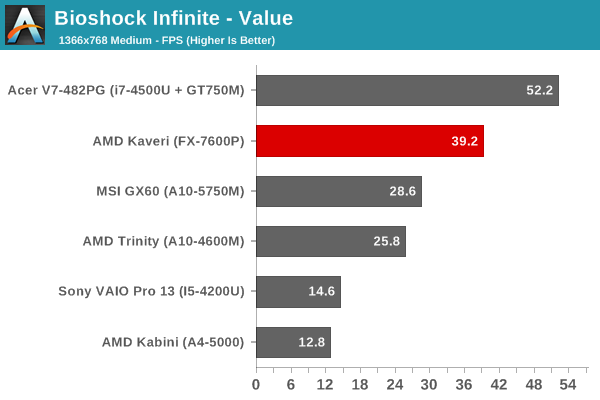
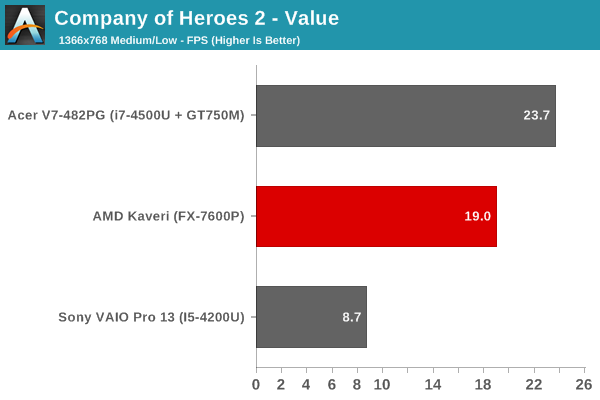
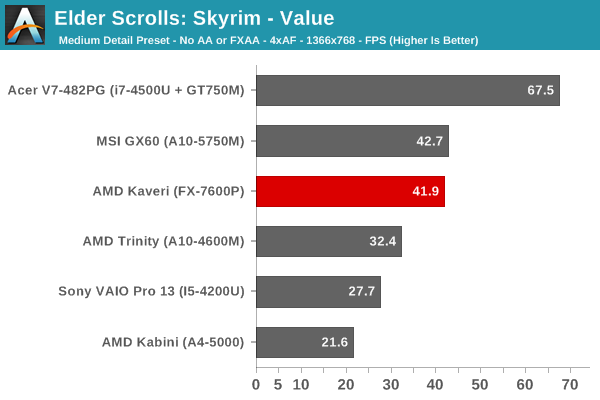
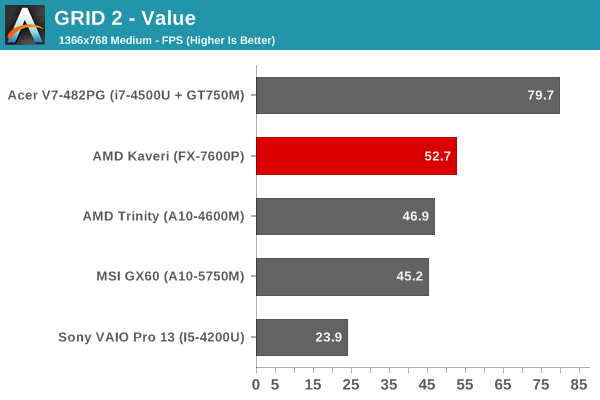

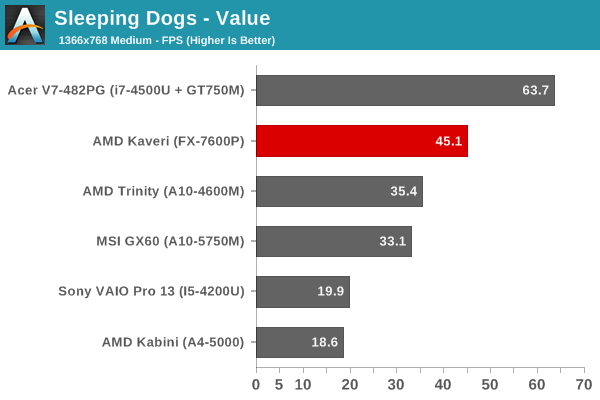
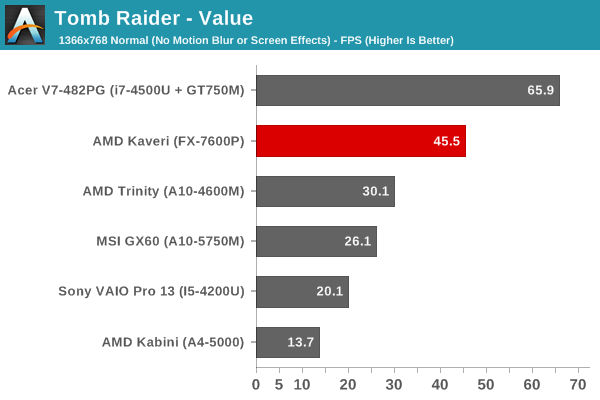
As expected, in most of the tests the Kaveri APU is able to surpass the gaming performance of every other iGPU, and in some cases it even comes moderately close to a discrete mainstream dGPU. There's a sizeable gap between the Trinity/Richland APUs and Kaveri in most of the games I tested, which is great news for those looking for a laptop that won't break the bank but can still run most modern games.
Getting into the particulars, Skyrim seems to be hitting some bottleneck (possibly CPU, though even then I'd expect Kaveri to be faster than Richland), but the vast majority of games should run at more than 30 FPS. There was one system with a pre-release Mantle driver installed that was running Battlefield 4 reasonably well at low/medium details, and with shipping laptops and drivers (and perhaps DDR3-2133 RAM) I suspect even Metro might get close to 30 FPS. Of course, we're only looking at the top performance FX-7600P here, so we'll have to see what the various 19W APUs are able to manage in similar tests.










125 Comments
View All Comments
Gigaplex - Wednesday, June 4, 2014 - link
"The comparison is for CPUs in the same price range, not CPUs in the same TDP range, obviously."For a mobile platform? I couldn't disagree more. Power consumption directly affects battery life, and you either need to spend more on the battery (negating cost savings) or just live with less runtime.
The_Countess - Sunday, June 15, 2014 - link
you can buy a LOT of extra battery capacity for the premium intel charges for its ULV CPU's. (a whole laptop battery replacement can be had for as little as 50 euro's.)furthermore most of the time, and most of the power, will be spent on idle, which is completely separate from the TDP. and again TDP is not power draw. the 2 don't even have to be related. a TDP is quit often set for a whole RANGE of CPU's so OEM's can make 1 laptop designed to one TDP and put a whole host of CPU's in it.
so without some actual power draw tests doing various tasks this speculation is useless.
Galatian - Wednesday, June 4, 2014 - link
It's even a bigger joke when they test Intel chips with the worst possible iGPU (HD4400). If you have to use 15W chips vs. a 35W chip in comparison at least take the best of the bunch aka one with a HD5000. Apple offers the MacBook Air for an incredible cheap price, while having a high builds quality. Though for AMD to get into designs like that. When you have a processor that cuts corners, than your entire product has to cut corners IMHO. I mean I can pay 600€ for a cut corner AMD notebook or I can spend 300€ and be a happy camper.Also dedicating so much text about why SSD are important doesn't really bode well for the product reviewed here...
hamoboy - Wednesday, June 4, 2014 - link
Well, Tom's Hardware takes a 35W Intel chip to compare their Kaveri test system to, and the Kaveri still absolutely smokes the Intel competitor in gaming. What Jarred is getting at in his reviews I think, is that it's no use for AMD to put out 19/17W chips if OEMs aren't going to bother making anything worth a damn with them inside.The comment about OEM's hamstringing AMD laptops is quite true, so many AMD laptops come out with single channel RAM and slow mechanical HDDs, but people attribute the low performance to the APU being slow, when for most purposes, any new mainstream chips coming from Intel or AMD are more than enough.
Galatian - Wednesday, June 4, 2014 - link
It doesn't "absolutely smoke" the Intel competition:1.) DOTA2 is actually faster on the Intel chip
2.) Frametime variance is better on the Intel chip through out (although admittedly probably moot point, since abysmal FPS anyway)
3.) It's a HD4600, so still not the better Intel iGPUs
Fergy - Wednesday, June 4, 2014 - link
If you take an Intel cpu with HD5000 (that is the one with the expensive L4 cache right?) doesn't that make it really really expensive so totally outside the market where AMD is putting these chips?System1: kaveri $500
System2: intel HD5000 $700
Consumers compare on price not on performance.
Galatian - Wednesday, June 4, 2014 - link
No. The HD5000 is actually what's Inside the MacBook Air for example, so a 15W ULV part. For 35W you have the Iris 5100 (which is still without the "expensive" eDRAM). Only some of the 45W chips have the Iris Pro 5200.I only have Apple as a reference but their notebooks are of high quality, don't cut corners and are actually affordable. The MacBook Air starting at 899€ and the 13" rMBP at 1299€. I would argue that an AMD equipped notebook which doesn't cut corners is not going to be much cheaper. In the end the price difference will be a question of weather you want the more powerful Intel chip or not.
Also I think AMDs claim of OpenCL performance I blown out of proportion. Their advertisement slides when Kaveri lunch actually had faked stats for Intels iGPU OpenCL performance. I did my own tests and received muh higher numbers. You can also check the PCMark and 3DMark websites to see that Intel was and is much better then what AMD wants you to believe. That is not to say that they are not better, I just think it needs to be put into better perspective if you really want to make the trade off (Better GPU for OpenCL but worse CPU)
nico_mach - Wednesday, June 4, 2014 - link
Your price comparison is off, though. Apple gets the highest end GPU chips from Intel, and then charges LESS than competitors. That Sony i5 was MORE expensive than the MBA or even the Mac Pro. Apple doesn't make cheap hardware, but they haven't had overpriced hardware in years (or no more than competitors).But I agree in principle, it just isn't going to happen for AMD. The HP sleekbook was easily the best looking 'ultrabook' and it was only briefly available (not that it was good, but lots of poor laptops do better). AMD is used by the OEMs only to keep Intel honest - and that's why they launched on desktop first. Intel doesn't really care about desktop, so AMD wisely chose that first, where they can get some enthusiasts as well as a few modest OEM wins.
I have an AMD chip and it was a good budget choice for a basic PC. But the OEMs are closer to adopting ARM en masse (HP has joined Samsung with ARM chromebooks now) than AMD. I'd like to think HSA might turn it around, but I think at this point Intel's guns are bigger than AMD's and they have more of them. Perhaps Lenovo will keep going vertical and scoop them up to move to China. They already have red logos, after all.
hamoboy - Wednesday, June 4, 2014 - link
1) That Dota2 result is so wide it seems like a result of driver non-optimization, than the Intel GPU actually being better.2) Like you said, it's a moot point.
3) The best Intel GPUs are found in chips that are way way out of AMD's price range. A true apples to apples comparison is between affordable midrange chips to affordable midrange chips, and that's what Tom's Hardware did.
Galatian - Thursday, June 5, 2014 - link
I agree on your first two points but beg to differ on the later. Not everybody is shopping with a set amount of money, most usually look what will 100€ more or less get me or what can I get in a given thermal envelope. I would argue for example that the HD5000 will turn out faster in the 19/15 W TDP envelope next to AMDs chips.Also I think most people are forgetting that AMD won't be competing with Haswell but with Broadwell which is close to be released.
Now this is not to say it's a bad chip, I just don't get the hype that's being made. I think the trade off worse CPU for better GPU is not worth it for most customers. HUMA and HSA still has to show how powerful it could be (and I have my doubts if it will ever get widespread attention) and people easily forget that Intel also supports OpenCL, so every software optimized for it will also run faster on Intel hardware.
In the end AMD chips - in my eyes - still remain the budget choice (if at all) and this is why you probably won't see many non cut corners notebooks.